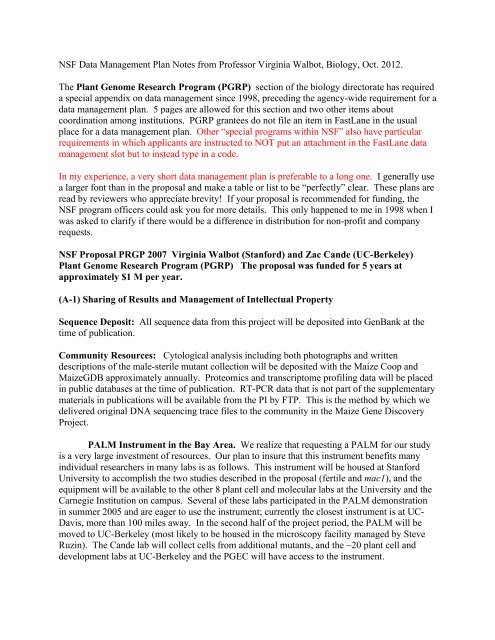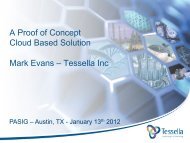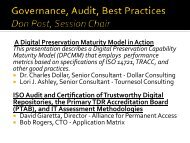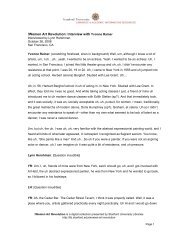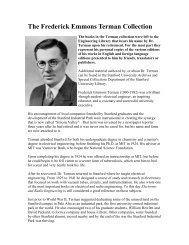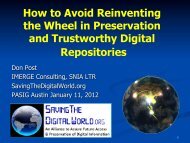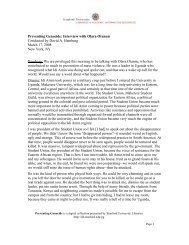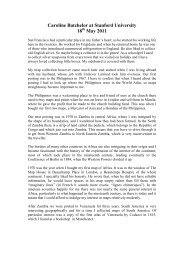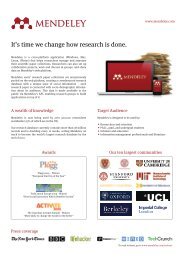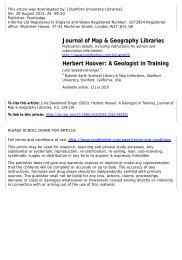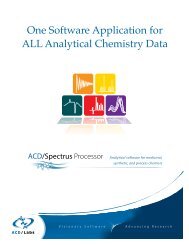Examples of three data management plans - (lib.stanford.edu ...
Examples of three data management plans - (lib.stanford.edu ...
Examples of three data management plans - (lib.stanford.edu ...
Create successful ePaper yourself
Turn your PDF publications into a flip-book with our unique Google optimized e-Paper software.
NSF Data Management Plan Notes from Pr<strong>of</strong>essor Virginia Walbot, Biology, Oct. 2012.<br />
The Plant Genome Research Program (PGRP) section <strong>of</strong> the biology directorate has required<br />
a special appendix on <strong>data</strong> <strong>management</strong> since 1998, preceding the agency-wide requirement for a<br />
<strong>data</strong> <strong>management</strong> plan. 5 pages are allowed for this section and two other items about<br />
coordination among institutions. PGRP grantees do not file an item in FastLane in the usual<br />
place for a <strong>data</strong> <strong>management</strong> plan. Other “special programs within NSF” also have particular<br />
requirements in which applicants are instructed to NOT put an attachment in the FastLane <strong>data</strong><br />
<strong>management</strong> slot but to instead type in a code.<br />
In my experience, a very short <strong>data</strong> <strong>management</strong> plan is preferable to a long one. I generally use<br />
a larger font than in the proposal and make a table or list to be “perfectly” clear. These <strong>plans</strong> are<br />
read by reviewers who appreciate brevity! If your proposal is recommended for funding, the<br />
NSF program <strong>of</strong>ficers could ask you for more details. This only happened to me in 1998 when I<br />
was asked to clarify if there would be a difference in distribution for non-pr<strong>of</strong>it and company<br />
requests.<br />
NSF Proposal PRGP 2007 Virginia Walbot (Stanford) and Zac Cande (UC-Berkeley)<br />
Plant Genome Research Program (PGRP) The proposal was funded for 5 years at<br />
approximately $1 M per year.<br />
(A-1) Sharing <strong>of</strong> Results and Management <strong>of</strong> Intellectual Property<br />
Sequence Deposit: All sequence <strong>data</strong> from this project will be deposited into GenBank at the<br />
time <strong>of</strong> publication.<br />
Community Resources: Cytological analysis including both photographs and written<br />
descriptions <strong>of</strong> the male-sterile mutant collection will be deposited with the Maize Coop and<br />
MaizeGDB approximately annually. Proteomics and transcriptome pr<strong>of</strong>iling <strong>data</strong> will be placed<br />
in public <strong>data</strong>bases at the time <strong>of</strong> publication. RT-PCR <strong>data</strong> that is not part <strong>of</strong> the supplementary<br />
materials in publications will be available from the PI by FTP. This is the method by which we<br />
delivered original DNA sequencing trace files to the community in the Maize Gene Discovery<br />
Project.<br />
PALM Instrument in the Bay Area. We realize that requesting a PALM for our study<br />
is a very large investment <strong>of</strong> resources. Our plan to insure that this instrument benefits many<br />
individual researchers in many labs is as follows. This instrument will be housed at Stanford<br />
University to accomplish the two studies described in the proposal (fertile and mac1), and the<br />
equipment will be available to the other 8 plant cell and molecular labs at the University and the<br />
Carnegie Institution on campus. Several <strong>of</strong> these labs participated in the PALM demonstration<br />
in summer 2005 and are eager to use the instrument; currently the closest instrument is at UC-<br />
Davis, more than 100 miles away. In the second half <strong>of</strong> the project period, the PALM will be<br />
moved to UC-Berkeley (most likely to be housed in the microscopy facility managed by Steve<br />
Ruzin). The Cande lab will collect cells from additional mutants, and the ~20 plant cell and<br />
development labs at UC-Berkeley and the PGEC will have access to the instrument.
Long-term Distribution: Clones, antibodies, and other resources will be distributed to public<br />
sector users at the time <strong>of</strong> publication without any "reach through" restrictions on use. Modest<br />
charges to cover shipping and handling may be assessed. Private sector user requests would be<br />
evaluated by the Office <strong>of</strong> Technology Licensing at Stanford University (see below) prior to<br />
distribution. All seed stocks in this project are already on deposit at the Maize Coop. For lines<br />
<strong>of</strong> particular interest, double mutants and improved and expanded stocks will be constructed by<br />
this research program. Such materials would be deposited at the Maize Coop at the time <strong>of</strong><br />
publication or by the end <strong>of</strong> the project for unpublished materials.<br />
Intellectual Property: As described above the seed stocks, other materials, and <strong>data</strong> from this<br />
project will be in the public domain, with free access to all. For some specialized biological<br />
reagents, The Office <strong>of</strong> Technology Licensing at Stanford University promotes the distribution<br />
<strong>of</strong> such materials from academic research into the private sector. Materials such as clones,<br />
antibodies, and other biological reagents are typically distributed after payment <strong>of</strong> a one-time fee<br />
($500 to $1000 per item). This fee is returned to the originating laboratory in a research account,<br />
and the PI and coPI would decide how to spend such funds. Stanford University and UC-<br />
Berkeley have a long history <strong>of</strong> cooperation in intellectual property issues. As part <strong>of</strong> the Maize<br />
Gene Discovery Project the issues related to EST clones, transposon tagged genes and their<br />
sequences, and maize genetics resources were thoroughly discussed in a meeting <strong>of</strong> the PI and<br />
coPIs and the technology licensing departments <strong>of</strong> these institutions. As the lead institution,<br />
Stanford will be responsible for coordinating and managing the intellectual property resulting<br />
from this GEPR award.<br />
2. NSF standard grant, Data Management Plan, 2011 Virginia Walbot PI<br />
Policy on and Experience with Rapid Dissemination <strong>of</strong> Results. Stanford University<br />
encourages rapid delivery <strong>of</strong> new <strong>data</strong> to public <strong>data</strong>bases after editing, annotating, and<br />
validation to meet community standards. The PI has extensive prior experience in this. For<br />
example, during production <strong>of</strong> >200,000 maize ESTs in the Maize Gene Discovery Project, our<br />
policy was to deposit trimmed <strong>data</strong> directly to GenBank in almost daily batches and then retrieve<br />
it for analysis, putting us on an equal footing with others interested in maize ESTs in terms <strong>of</strong><br />
contig assembly, gene identification, etc. Similarly, during the Maize Full Length cDNA<br />
Sequencing Project managed by the University <strong>of</strong> Arizona finished full length cDNAs were<br />
released to GenBank in batches after the painstaking clone validation proc<strong>edu</strong>re, and these clones<br />
were then simultaneously available for distribution at a nominal cost by the University <strong>of</strong><br />
Arizona. In both these projects individual community requests for additional information were<br />
addressed within one or two days by V. Walbot, i.e. to send untrimmed sequence <strong>data</strong>, to provide<br />
additional <strong>lib</strong>rary information, to provide clones in advance (at a nominal cost), etc. In both<br />
projects we also cooperated with individual investigator and large project requests for our<br />
<strong>lib</strong>raries, arrayed plates with cDNA or FLcDNAs plasmids in a timely manner. We recently<br />
published (Pimentel et al. 2011) a method for displaying genetic records and family trees, and<br />
made our own records the example (http://www.<strong>stanford</strong>.<strong>edu</strong>/~walbot/geneticrecords.html );<br />
those requesting seed can look up from a computer or Smartphone all information about our<br />
stocks and hence pinpoint precisely which stocks will work best for them. This tool has<br />
increased our requests about five-fold in the past year.
MaizeGDB will be our primary portal for dissemination <strong>of</strong> results. A key early<br />
decision in our current PGRP project was that we would not build a project website, but instead<br />
rely on MaizeGDB for <strong>data</strong> dissemination. MaizeGDB uses us as an example <strong>of</strong> a model project<br />
as we partially fund a specific employee (Dr, Lisa Harper, 50% FTE at MaizeGDB working from<br />
the Plant Gene Expression Center, Albany CA) who participates in our PGRP project, is a coauthor<br />
on papers to which she contributed, and is responsible for <strong>data</strong> entry into MaizeGDB<br />
including cytological image evidence <strong>of</strong> hundreds <strong>of</strong> male-sterile lines. For the Maize-Ustilago<br />
project the volume and complexity <strong>of</strong> <strong>data</strong> are much lower, and <strong>data</strong> deposit into MaizeGDB will<br />
be performed by the PI and postdoctoral fellows. The following <strong>data</strong> types are anticipated:<br />
Table 1. Data types from this project and how they will be disseminated.<br />
http://www.<strong>stanford</strong>.<strong>edu</strong>/~walbot/ = lab website<br />
http://www.<strong>stanford</strong>.<strong>edu</strong>/~walbot/geneticrecords.html = genetic records<br />
Data type Where Deposited When # By Whom<br />
Microarray & RNA- Track at Maize GDB Within 3 months <strong>of</strong> PI<br />
Seq<br />
and GEO<br />
<strong>data</strong> validation by<br />
qRT-PCR<br />
Small protein Track at Maize GDB Within 3 months <strong>of</strong> PI<br />
proteomes<br />
<strong>data</strong> validation<br />
Availability and use Posters, publications, When we have PI and Research team<br />
<strong>of</strong> FRET sensors in and lab website validated use with a<br />
transgenic maize<br />
robust scientific study<br />
Phenotypic <strong>data</strong> on Posters, publications, Publications PI and Research team<br />
Ustilago-maize<br />
interaction<br />
and lab website<br />
Ustilago gene cloning Posters and<br />
After publication Gunther Doehlemann<br />
and allele analysis publications<br />
distributes Ustilago<br />
stocks<br />
Availability and use Posters, publications,<br />
PI in collaboration<br />
<strong>of</strong> endoscopes and lab website<br />
with Mark Schnitzer<br />
3. NSF Proposal (~$4.4 M for four years, 3 years funded plus 1 year extension) from the<br />
PGRP.<br />
Yeisoo Yu, PI University <strong>of</strong> Arizona, Cari Soderlund coPI <strong>of</strong> Arizona, Virginia Walbot coPI<br />
Stanford Plant Genome Research Program 2004 - 2007<br />
A-1. Sharing <strong>of</strong> Results and Management <strong>of</strong> Intellectual Property<br />
Maize Full-length cDNA Project<br />
A-1.1 It is our explicit intention that all <strong>data</strong> derived from this project be placed in public<br />
<strong>data</strong>bases as soon as produced and quality checked as outlined in the project description.<br />
Specifically:<br />
1) All single-pass cDNA sequences will be deposited in dbEST Genbank at weekly
intervals.<br />
2) All finished FL-cDNA sequences will be deposited in dbEST Genbank.<br />
3) cDNA clones produced from this proposal will be made publicly available from Arizona<br />
Genomics Institute (AGI) BAC/EST Resource Center in University <strong>of</strong> Arizona.<br />
4) High-density filter arrays <strong>of</strong> the full-length cDNA set will be available to the community<br />
through the AGI BAC/EST Resource Center.<br />
5) Aliquots <strong>of</strong> amplified cDNA <strong>lib</strong>aries 1 and 2.<br />
There are no IP issues (restrictions) related to the use <strong>of</strong> any <strong>of</strong> the materials.<br />
A-1.2 Making the public aware <strong>of</strong> our new resources. Public awareness <strong>of</strong> the resources will<br />
be through, AGI and Stanford websites, as well as collaborative web links from Gramene and<br />
MaizeGDB <strong>data</strong>bases to our <strong>data</strong>base and AGI webbased ordering system<br />
(http://genome.arizona.<strong>edu</strong>/orders) for accurate and easy clone identification and distribution.<br />
We will provide community awareness <strong>of</strong> our resources produced at scientific conferences, from<br />
emails and direct conversations.<br />
A-1.3 All clone distribution will be handled through the AGI BAC/EST Resource Center.<br />
Distribution <strong>of</strong> resources requiring protection <strong>of</strong> Intellectual Property is handled by a community<br />
member’s institution providing a signed standard Universal Biological Material Transfer<br />
Agreement (UBMTA). An example <strong>of</strong> the AGI MTA is available at AGI web ordering system<br />
(http://www.genome.arizona.<strong>edu</strong>/orders/).<br />
A-1.4 Fees charged by the AGI BAC/EST Resource Center for resources are based on cost<br />
recovery and take into account the cost <strong>of</strong> all reagents, labor, shipping, service contracts and<br />
instrument depreciation. The pricing structure is as follows:<br />
Pricing to academic institutions Pricing to for pr<strong>of</strong>it companies<br />
• Library $12.00/plate plus shipping $50.00/plate plus shipping<br />
• Clones $6.00/clone plus shipping $30.00/clone plus shipping<br />
• High-density filter arrays $150.00/filter plus shipping $250.00/filter plus shipping<br />
• Amplified Library $250.00/1ml aliquot <strong>of</strong> amplified <strong>lib</strong>rary. Not available until the end<br />
<strong>of</strong> the project


